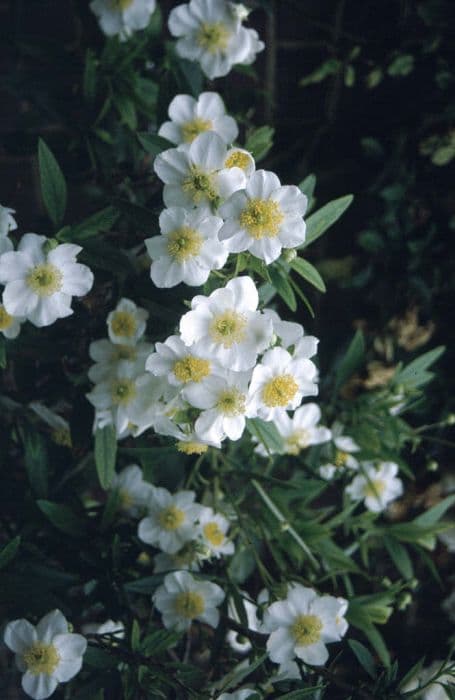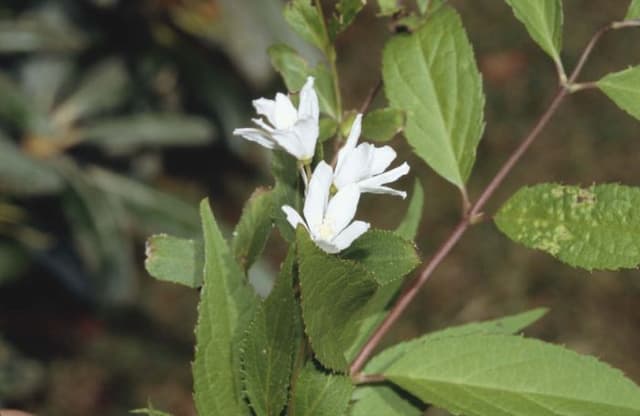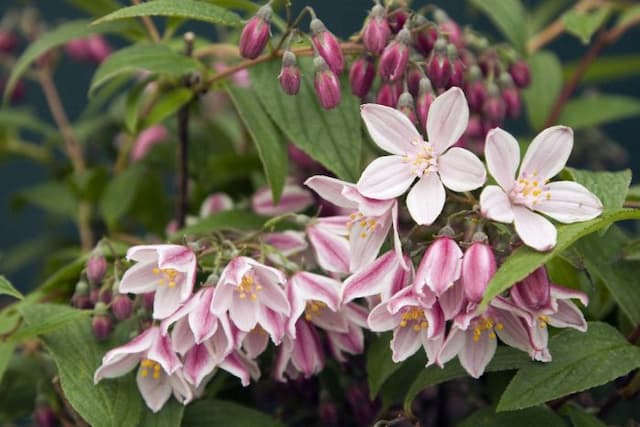Japanese Hydrangea Vine Schizophragma hydrangeoides var. concolor 'Moonlight'

ABOUT
The plant commonly known as Japanese hydrangea vine 'Moonlight' is characterized by its striking foliage and decorative floral appearance. The leaves are heart-shaped and have a unique silvery-green coloration with a hint of blue, which creates a moonlit effect. The edges of the leaves are irregular and subtly toothed, contributing to the textured look of the plant. During the blooming period, the plant produces lacecap flowers, which are composed of small, fertile flowers surrounded by larger, showy sterile flowers. These sterile flowers are often white and give the impression of delicate lacework. The contrast between the luminous foliage and the white blooms creates a visually arresting display that can add interest to any garden or wall upon which it climbs.
About this plant
 Names
NamesFamily
Hydrangeaceae.
Synonyms
Japanese Hydrangea Vine, Moonlight Climbing Hydrangea, Moonlight Hydrangea Vine, Moonlight Japanese Hydrangea Vine.
Common names
Schizophragma hydrangeoides var. concolor, Schizophragma hydrangeoides 'Moonlight'.
 Toxicity
ToxicityTo humans
Japanese hydrangea vine is not commonly known to be toxic to humans. However, as with any plant, individual sensitivities can occur, and it is always advised to avoid ingesting parts of ornamental plants due to potential unknown personal reactions or possible contamination with garden chemicals.
To pets
Japanese hydrangea vine is also not commonly known to be toxic to pets. But as with humans, pets may have individual sensitivities, and ingesting plant material can sometimes lead to gastrointestinal upset such as vomiting or diarrhea. It is always best to prevent pets from chewing on ornamental plants.
 Characteristics
CharacteristicsLife cycle
Perennials
Foliage type
Deciduous
Color of leaves
Blue-green
Flower color
White
Height
30 feet (9 meters)
Spread
6 feet (1.8 meters)
Plant type
Climber
Hardiness zones
5
Native area
Japan
Benefits
 General Benefits
General Benefits- Ornamental Value: Adds visual interest to gardens with its heart-shaped, silver-infused leaves and lacecap flowers.
- Shade Tolerant: Grows well in partial to full shade, making it useful for underplanting or in shaded areas of the landscape.
- Versatile Climbing Habit: Can be trained to climb up walls, fences, or trees, offering vertical interest and versatility in landscaping.
- Wildlife Support: Attracts pollinators like bees and butterflies with its flowers, adding to the biodiversity of the garden ecosystem.
- Low Maintenance: Requires minimal care once established, making it suitable for gardeners with limited time.
- Seasonal Interest: Provides beauty throughout the growing season with changing leaf colors and summertime blooms.
- Drought Tolerance: Once established, it has good resistance to drought, reducing the need for frequent watering.
- Cold Hardy: Can survive in colder climates down to USDA hardiness zone 5, making it adaptable to various environments.
- Deciduous Nature: Sheds its leaves in fall, which can be used as mulch to improve soil health and suppress weeds.
 Medical Properties
Medical PropertiesThis plant is not used for medical purposes.
 Air-purifying Qualities
Air-purifying QualitiesThis plant is not specifically known for air purifying qualities.
 Other Uses
Other Uses- Japanese hydrangea vine can be used in art installations or as a muse for botanical artists due to its unique foliage and climbing habit, providing a natural and textured backdrop alongside other garden features.
- The vine's lush leaves can serve as a natural privacy screen when grown on fences or trellises in residential gardens, creating secluded spaces without the need for artificial materials.
- Innovative chefs may use the large, heart-shaped leaves as an organic serving platter or decorative element to present food, although the plant is not edible and should not come into direct contact with food.
- Landscape designers may utilize the vine to cover unsightly garden elements such as old stumps or sheds, effectively recycling living plants for aesthetic purposes.
- Japanese hydrangea vine can be trained to grow over rocks and garden sculptures, giving them a mystic, aged appearance as if reclaimed by nature over time.
- Its ability to cling to surfaces and grow vertically makes it an interesting addition to vertical gardens in urban environments, where green space is limited.
- During autumn, the foliage provides spectacular color changes, making it useful for seasonal displays in public parks and gardens.
- The plant can be incorporated into educational programs at botanical gardens, showcasing the diversity of climbing plants and their adaptations to students and visitors.
- Crafters may collect the dried, brownish exfoliated peels of the vine's bark for use in rustic or natural-themed craft projects.
- Gardeners may use the vine's tendency to climb and cover surfaces as a living art project, training and shaping the plant over time to create living sculptures.
Interesting Facts
 Feng Shui
Feng ShuiThe Japanese hydrangea vine is not used in Feng Shui practice.
 Zodiac Sign Compitability
Zodiac Sign CompitabilityThe Japanese hydrangea vine is not used in astrology practice.
 Plant Symbolism
Plant Symbolism- Mystery: The Schizophragma, commonly known as Japanese hydrangea vine, often grows in a twisted manner upon trees and walls, symbolizing the mysterious ways in which nature works.
- Support: As a climbing plant, the Japanese hydrangea vine supports itself on other structures, which can be seen as a symbol of reliance and interdependence.
- Adaptation: Schizophragma hydrangeoides thrives in various conditions, symbolizing adaptability and the ability to thrive in different environments.
- Love and Devotion: In some cultural contexts, hydrangea variations, including the Japanese hydrangea vine, are often associated with heartfelt emotions, gratitude, or apologies.
- Grace: The 'Moonlight' variety of Schizophragma, with its subtle and elegant silver-blue foliage, symbolizes grace and serene beauty.
 Water
WaterThe Japanese hydrangea vine should be watered deeply and thoroughly, making sure the soil is evenly moist but not waterlogged. During the growing season, this may mean watering approximately once a week with 1 to 2 gallons of water, depending on the climate and weather conditions. It's crucial to reduce the frequency during winter to prevent root rot, watering only when the top inch of soil feels dry to the touch. These guidelines can vary based on your environment, so it’s important to monitor the soil moisture and adjust your watering schedule accordingly.
 Light
LightJapanese hydrangea vine thrives in partial shade to full shade, making it an excellent choice for north-facing walls or under the canopy of larger trees. It should be protected from harsh, direct sunlight, especially during the hottest parts of the day. The ideal lighting condition is dappled sunlight, which provides a balance of light and protection for the delicate foliage.
 Temperature
TemperatureThe Japanese hydrangea vine prefers temperate conditions and does well in a range between 60°F to 80°F, which are considered ideal. It can survive minimum winter temperatures down to around 20°F but may suffer if the temperatures dip below that point. Throughout its growing season, maintaining a temperature within its preferred range will support healthy growth and flowering.
 Pruning
PruningPrune the Japanese hydrangea vine in late winter or early spring before new growth begins to remove any dead or damaged wood and to maintain the desired shape. It's also a good practice to cut back the plant every few years to rejuvenate growth and improve air circulation, which helps prevent disease. Pruning can be done annually, but a more extensive cutback may only be necessary every three or four years.
 Cleaning
CleaningAs needed
 Soil
SoilJapanese hydrangea vine thrives in well-drained yet moist soil with high organic matter content. A mix of loam, peat, and perlite or sand is ideal, ensuring good aeration and water retention. The soil pH should be slightly acidic, around 5.5 to 6.5.
 Repotting
RepottingJapanese hydrangea vines do not require frequent repotting as they are slow-growing. Repotting every 2-3 years or when the plant becomes rootbound is sufficient to maintain good health.
 Humidity & Misting
Humidity & MistingJapanese hydrangea vines prefer high humidity levels, usually around 60-80%. Consistently moist air without being too dry promotes healthy foliage and growth.
 Suitable locations
Suitable locationsIndoor
Provide bright, indirect light and maintain high humidity.
Outdoor
Plant in partial shade; protect from harsh sun and wind.
Hardiness zone
5-9 USDA
 Life cycle
Life cycleJapanese hydrangea vine 'Moonlight' begins its life as a seed, which, under the right conditions of moisture and temperature, will germinate and develop a root system and a shoot that emerges from the soil. The plant then enters its juvenile stage, growing rapidly and producing large, heart-shaped silver-blue leaves with dark green veining, while climbing on supports or other plants with aerial rootlets. As it matures, it will begin to flower, typically during the summer months, producing clusters of white, lace-cap flowers that resemble those of true hydrangeas. After pollination, these flowers may develop into dry, brown seed capsules, which will release seeds when mature, completing the reproductive cycle. Throughout the growing season, the plant will engage in vegetative growth, expanding in both height and coverage, and it may also undergo periods of dormancy in winter, where growth slows or stops and the plant conserves energy. Over the years, the Japanese hydrangea vine 'Moonlight' can become a large, established presence on structures or trees, with a lifespan that can extend for several decades under optimal conditions.
 Propogation
PropogationPropogation time
Spring-Early Summer
For the Japanese hydrangea vine 'Moonlight', the most popular method of propagation is by softwood cuttings. This is typically done in early summer when the plant's new growth is semi-mature but still pliable. Cuttings should be about 4 to 6 inches long (10 to 15 cm), with several sets of leaves. The bottom set of leaves is removed, and the cut end can be dipped in rooting hormone to encourage root growth. The cutting is then planted in a well-draining soil mix and kept in a humid environment with indirect light until roots develop, which could take several weeks. It's crucial to keep the soil moist but not waterlogged to prevent the cutting from rotting.







![Hydrangea [Strong Annabelle]](/_next/image?url=https%3A%2F%2Fplants-admin.emdemapps.com%2Fimages%2Fplants%2F%2Fimages%2F604b54db37d34.png&w=640&q=75)

